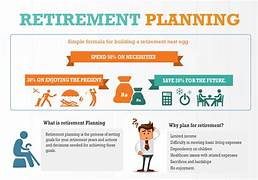Retirement planning is the process of accumulating assets and managing expenses in anticipation of retirement. It is important to start planning for retirement early, as it can take many years to save enough money to live comfortably in retirement.
There are a number of factors to consider when planning for retirement, including:
- Your current age and income. How old are you now? How much money do you earn each year?
- Your expected retirement age. When do you plan to retire?
- Your desired retirement lifestyle. How much money do you expect to spend each year in retirement?
- Your current savings and investments. How much money do you have saved for retirement? What types of investments do you have?
- Your expected Social Security benefits. How much money do you expect to receive from Social Security in retirement?
- Your health insurance needs. How will you get health insurance in retirement?
- Your long-term care needs. How will you pay for long-term care if you need it?
Once you have considered these factors, you can develop a retirement plan. Your plan should include a savings goal, a budget, and an investment strategy.
Savings goal. How much money do you need to save for retirement? A good rule of thumb is to save 15% of your income for retirement. However, you may need to save more or less, depending on your desired retirement lifestyle and expected expenses.
Budget. Once you know how much money you need to save, you need to create a budget to help you reach your savings goal. Your budget should track your income and expenses so that you can see where your money is going. You can then make changes to your spending habits to free up more money for retirement savings.
Investment strategy. You need to choose investments that will help you grow your savings over time. There are a variety of investments available, including stocks, bonds, and mutual funds. You should work with a financial advisor to choose investments that are appropriate for your risk tolerance and time horizon.
Retirement planning can be complex, but it is important to start planning early. By taking steps to save for retirement now, you can ensure that you have a comfortable and secure retirement later in life.
Here are some additional tips for retirement planning:
- Start saving early. The earlier you start saving for retirement, the more time your money has to grow.
- Take advantage of tax-advantaged retirement savings plans. There are a number of tax-advantaged retirement savings plans available, such as 401(k)s, IRAs, and HSAs. These plans can help you save money on taxes and grow your savings faster.
- Rebalance your portfolio regularly. As you get closer to retirement, you need to adjust your investment portfolio to become more conservative. This will help you reduce your risk and protect your savings from market volatility.
- Consider working part-time in retirement. If you need additional income in retirement, you may want to consider working part-time. This can help you supplement your Social Security benefits and keep you active and engaged.
- Get professional help. If you are not sure how to start planning for retirement, you should consider working with a financial advisor. A financial advisor can help you create a personalized retirement plan and make sure that you are on track to reach your retirement goals.
Retirement planning can be a daunting task, but it is important to remember that you are not alone. There are a number of resources available to help you get started. With careful planning and execution, you can ensure that you have a comfortable and secure retirement.















